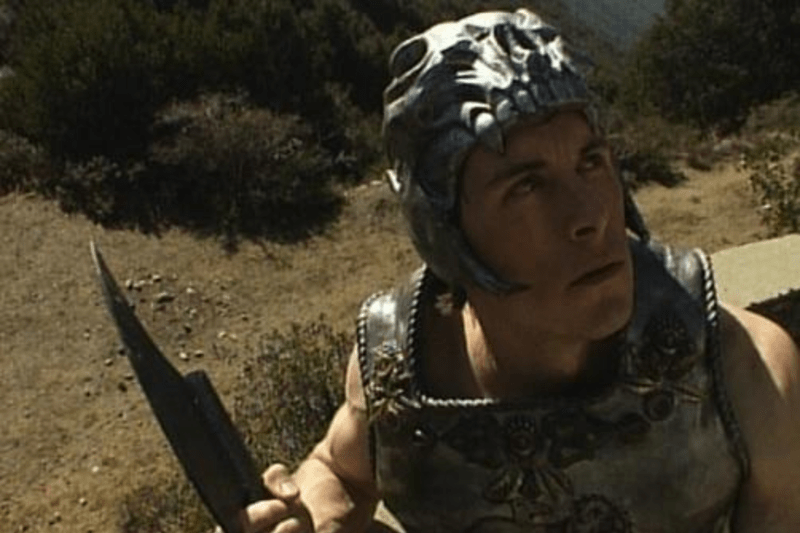Forget B-movies: with its public access-worthy production values, cardboard characters, and visual effects more suitable for a cut-rate haunted house than the silver screen, Jay Woelfel's Demonicus is more like Z-grade schlock. It's still one of the most metal movies of all time.
Once the title card for Full Moon Pictures lands in the opening credits—scored, of course, with a single-note synthetic whine—you know what you’re in for. This is the kind of movie where California’s Angeles National Forest is meant to double for the Italian Alps. Soon, the “Alps” will be explored by a cadre of young, oblivious adventure-seekers, most of whom will get picked off, one by one, by a modern or ancient menace.
Demonicus follows a group of seven young hikers who make the brilliant decision to split up to see who can reach base camp first. We first meet James (Gregory Lee Kenyon) and Charlene (Val Perez), who is less than thrilled about hiking two days into the Alps. To quell her protests, James suggests she lie down for a moment on a comfy stack of rocks while he investigates that not-at-all-sinister cave that appeared out of nowhere.
Inside, he finds a perfectly preserved desiccated corpse decked out in full gladiator regalia—complete with a wicked skull helmet—which James decides, as you do, to try on. This allows the spirit of Tyranus, an ancient evil gladiator who fought alongside Spartacus, to take over his body.
We are then treated to a suiting-up montage over a bedrock of epic synthetic strings that would make Glenn Danzig blush. James-slash-Tyranus dons the totally-not-styrofoam gladiator armor, lit by eerie green ectoplasm lighting. He immediately kills his girlfriend with a gut stab, resulting in a glorious lens blood splatter. And this is all before the titles roll.
Next, Demonicus introduces us to the rest of the motley crew—Frankie (Dominic Catrambone as Dominic Joseph), Teresa (Candace Kroslak), Joe (Kyle Tracy), Anthony (Allen Nabors), Maria (Jennifer Capo), Dino (Brannon Gould), and Gina (Venesa Talor). Gina is a professor with an interest in Etruscan history and a very in-depth guidebook to Rome—which contains details about the Italian Alps and an ancient slave uprising, naturally.
(Don't bother trying to remember who's who—most characters' main memorable trait is the color of their jacket and hair. They won't be sticking around long enough to get attached.)
What follows next should come as little surprise, as characters are picked off one by one with an arsenal of also totally-not-cardboard ancient gladiator weapons. The biggest surprise is their complete lack of survival instinct, as most simply stand there and scream as their limbs are lopped off.
The other main surprise is what those limbs are used for. James-slash-Tyranus is preparing a hiker stew, tossing Spirit Halloween-worthy arms, legs, and skulls into a burbling cauldron while chanting Latin in an attempt to bring the real Tyranus back to life.
Demonicus' final third gets underway with the abduction of Maria, causing Joe and Dino to go full Rambo and go head-to-head against Tyranus. The final fight scene is a bit underwhelming but it does feature a Ray Harryhausen-esque reanimated corpse played by VFX artist Todd Rex. Rex would go on to work on massive blockbusters like I Am Legend, Aquaman, and the Westworld TV series, which makes Demonicus one of his few acting roles.
The ending throws in a little confusion for good measure, having Maria slip on the skull helmet after vanquishing the ancient evil. This reveals the lost statue of Tyranus erected by the Ancient Romans to commemorate his tomb. The statue immediately breaks apart into a mountain of very unconvincing CGI boulders. Does that mean Maria was buried beneath invisible rubble? Maybe director Woelfel will make a sequel one day and let us know.
For all its Z-movie silliness, there are numerous details that make Demonicus stand out from the endless carbon copy slashers that used to dominate local video stores. The mountainous setting of the "Italian Alps" is Demonicus' main selling point, making it immediately distinctive in a genre full of crumbling summer camps and moldering houses. Pair this with plenty of overhead shots, long before the era of drones, and it's clear Woelfel cared and had a vision that he did his best to realize.
For those who value style as much if not more than substance, the low-budget haunted house aesthetic works in Demonicus' favor. As noted previously, the black magic resurrection scenes have a ghoulish guignol glory to them, with their directional ectoplasm green lighting and fog machines working overtime. Demonicus is ripe for rediscovery for doom, black, and thrash Metal bands looking for some new material for their video backdrops.
Even with the ambitious overhead shots, Demonicus' production values still leave something to be desired, with more fades and screen wipes than a first-year A/V course. Lighting and makeup seem to be optional. And while there's something to be said for the audacity to use Southern California's—ahem, Italian—natural golden light. It doesn't do the shot-on-video production any favors, though, leaving Demonicus sometimes feeling slightly washed out and drab.
(The soundtrack and sound design could use a little attention, too, as there's a constant string stinger drone sustained throughout nearly the entire movie as if the eyeliner-wearing composer passed out on his Casio's upper register.)
With its local haunted house production values and novel mountainous setting, Demonicus stands out from the scores and scores of forgettable slashers. In many ways, its low budget works to its advantage; everything about Demonicus' lair is utterly badass, from its overdriven fog machine to its slime-green lighting to the manticore cave paintings. Demonicus is worth a watch for the Ray Harryhausen meets Army of Darkness showdown in the film's thrilling crescendo alone. Add in a truly committed performance from Gregory Lee Kenyon as the gladiator-possessed and you get one of the most truly metal movies of all time, one that is well-deserving of a spot among the slasher canon (whatever the haters may say).







